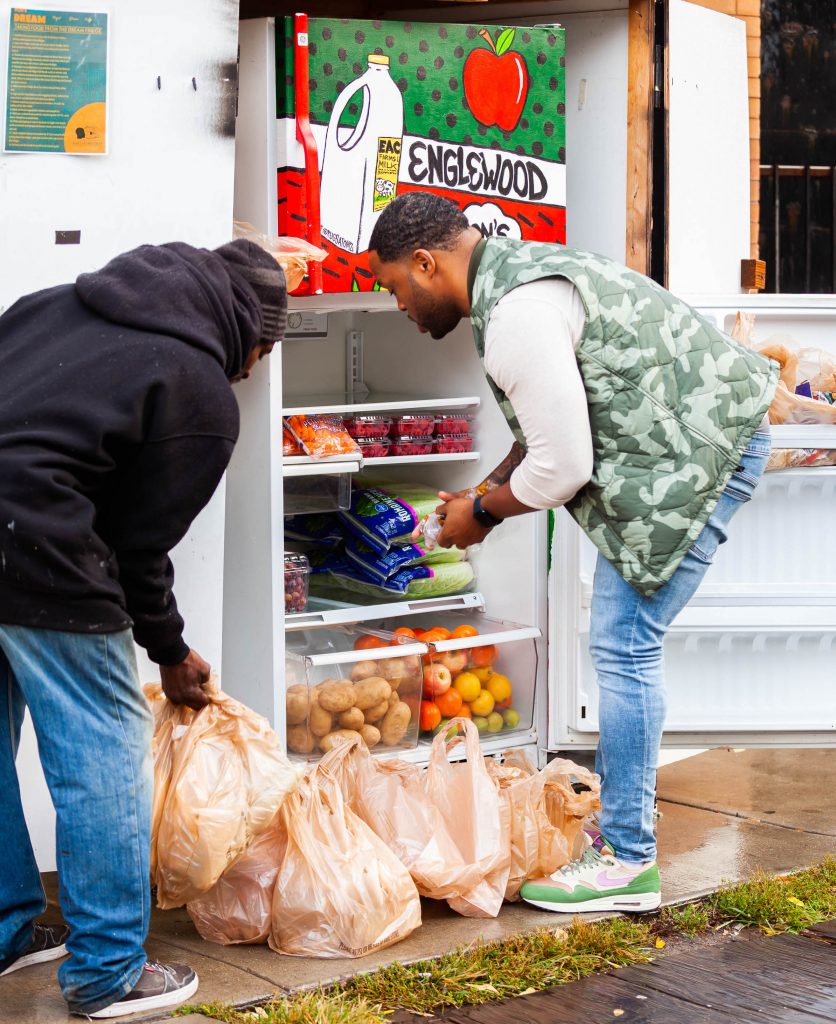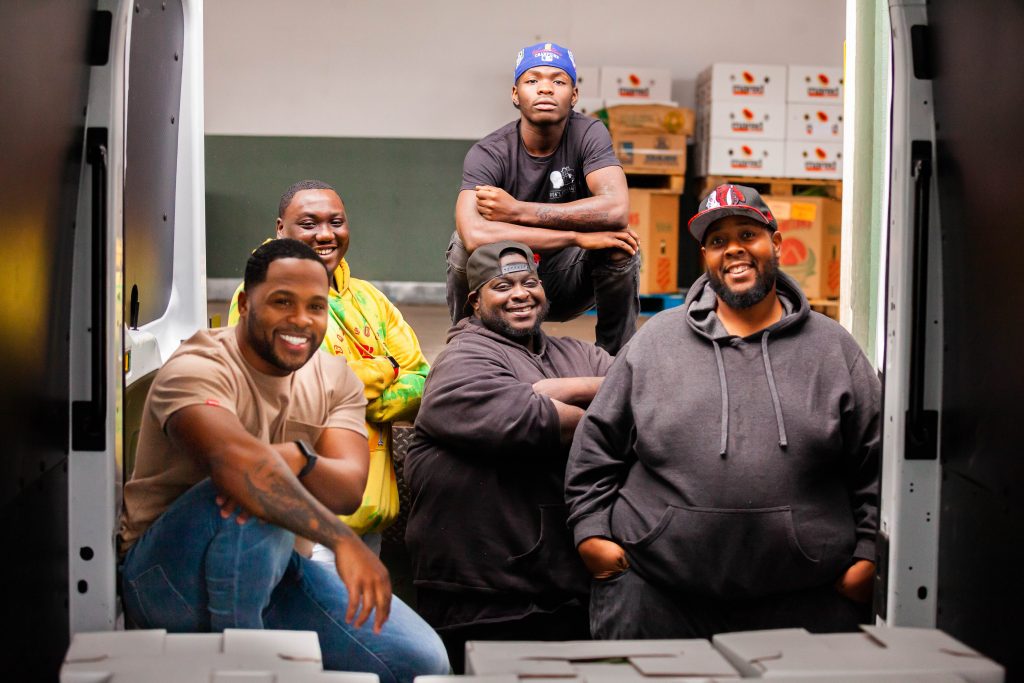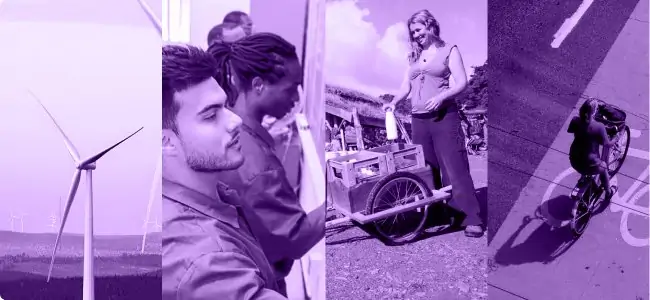This is one of a pair of stories exploring efforts to make donated food healthier, more delicious and more dignified. You can read the other story here.
Dion Dawson’s day starts around 8 am at the corner of 59th Street and Racine Avenue in Chicago’s Englewood neighborhood. Most days, his six-year-old son Bryson accompanies him, eager to help stock the community fridge labeled with “FREE FOOD” in sky blue letters. Usually, the area’s residents have already gathered around the fridge, which has been spray-painted with happy cows, bright red apples, yellow corn and potatoes, as Dawson puts in oranges, lettuce and strawberries. He hands out bananas and grapes, too.
“Always grapes,” he emphasized. “When I grew up food insecure, I never got to eat fresh grapes, ever. So I make sure we always have fresh grapes. That may not be cost effective, but it makes a difference.”
Dawson sets up the Chicago nonprofit Dion’s Chicago Dream and the community fridge in 2020. He added a free weekly produce home delivery service in 2021. Both address the lack of access to fresh fruit and vegetables endemic to food deserts — areas that lack supermarkets and are typically low-income. They are also inspired by Dawson’s past food insecurity as well as his negative experiences with donation boxes from food banks.
“More than 500,000 Chicago residents live in a food desert,” Dawson says, citing American Community Survey data. “More than half of our residents will be food insecure in our community within this year.”

The Englewood fridge is accessible all day, unmanned, for anyone to take as much fresh produce as they like. “The opportunity to consume fresh fruits and vegetables is not something that I am used to,” said one resident, Terence. “I feel sometimes that I don’t deserve it because no one has cared to offer it to us consistently.”
Dawson spent six years in the Navy and experienced 14 years of homelessness before and after his service. “I grew up with three brothers and a single mom who struggled with addiction,” he says via Zoom from his mother’s house in Englewood. His mother recently survived kidney cancer, and he made her the executive assistant of his nonprofit. “We often went hungry or lived three days on potato chips,” Dawson remembers.
What stuck with him most, though, wasn’t just the hunger but the dehumanization he felt at the food banks. “I’ll never forget that horrible soaking wet day when my family had to wait outside for hours as the rain poured down on us, only to be rewarded with expiring fruits, unlabeled canned goods and a box of raisins.” Maybe worse than the food was the shame he associated with the experience. “Nobody looks you in the eye. Nobody connects with you. You are given a box of discarded food, most of it food you wouldn’t normally eat, and it is such a humiliating experience.”
This is the reason he decided to do everything differently with Dion’s Chicago Dreams. “We focus on the recipient instead of the donor’s experience. We connect with people.”
His project was launched as a spontaneous idea when a friend challenged him in 2020 with: “What are you going to do for Juneteenth?” Dawson responded on a whim, “I’m going to feed 100 families.” He raised $2,500 on GoFundMe, bought 100 pounds of food and fed 96 families. “After that, I said, let’s go for it, and I started Dion’s Chicago Dream.” He taught himself how to set up a nonprofit, and in September 2020, he began stocking the community fridge in Englewood, working out of his car.
“Since its inception, Project Dream Fridge has provided more than 36,000 pounds of fresh food and water,” Dawson says, at a weekly cost of $550. Through the weekly home deliveries, he and his seven employees now deliver to 375 homes per week, feeding 2,000 people in 23 neighborhoods with 15,000 pounds of fresh produce per month. “We move more produce than Walmart,” he quips, at a cost of about $1,000 per family per year. “We have that tangible impact.”
Supported by donations from locals like rapper G Herbo and organizations such as the Obama Foundation, what he delivers is exclusively fresh produce. Bananas, cucumbers, spinach, mango, whatever is in season and available from its wholesale supplier, JAB Produce. “The food is wow!” 65-year-old Alice Lesure says while she is preparing collard greens and cabbage from the most recent delivery for lunch. She has known Dion Dawson for “20-plus years” because her son went to school with Dawson, and she reached out to the nonprofit through her son. “I’m on disability. I eat healthier now and don’t have to worry about buying fresh vegetables anymore.”
Sherry Phillips, 63, says she enjoys “Googling new recipes” for foods she has never tried before, such as eggplants and squash. According to her, the delivered produce “is better than you can find in a store, unbruised.” She contrasts this with her experience at her church’s food pantry. “The bags had mouse droppings in them, and I threw everything out.”
Dawson’s goal is “to challenge the very model of food distribution,” he says. “It’s challenging philanthropy at its core, shifting from a donor-focused model to a recipient-based one.” He laments “the same inefficient programming and the same lack of end-user experience” in the traditional food supply programs. “No follow-up. Nothing has changed in more than 25 years. I mean, after all the industries and sectors we’ve innovated in the last 25 years, I think it’s time we do the same for food distribution in the philanthropic sector.”
Crushed by negative news?
Sign up for the Reasons to be Cheerful newsletter.
Therefore he draws “a hard line against used food. Why do we give people old shit?” He asks recipients to fill out feedback forms about how satisfied they are with their deliveries, just as companies do with paying customers.
“What if we treat feeding the hungry like any other business?” he asks. “By bringing dignity, respect and accountability into food distribution in the philanthropic sector along with a commitment to quality.”
The American Diabetes Association has just signed on to cooperate with Dawson, which will allow Dawson to expand deliveries to more households. “Low-income residents of these neighborhoods and those who lack transportation rely more on smaller neighborhood stores that may not carry healthy foods or may offer them only at much higher prices,” said Charles D. Henderson, CEO of the American Diabetes Association, in an ADA announcement. “This partnership will be a game changer and a model to replicate across the United States.”
‘Food is the starting point’
Dawson is not the only one focused on access to fresh fruits and vegetables and addressing the drawbacks of the traditional food pantry system.
In 2021, the Penn Medicine Center for Health Equity Advancement (CHEA) created FAST (Food Access Support Technology), a platform that connects health care providers, community-based organizations (CBOs) and minority-owned small businesses to fight food insecurity in Philadelphia . Penn, which identified more than 300,000 Philadelphia residents as food insecure, now routinely screens patients for food insecurity before discharging them from the hospital.
Covid exacerbated the problem that ill or disabled residents often cannot access food pantries. And for people with diabetes or other chronic health issues, carbohydrate-laden staples such as rice and pasta that are routinely found in food pantries, aren’t helpful for managing patient’s weight or blood pressure. Penn’s CHEA initiatives grew out of a project that helped get food to vulnerable populations during Covid by pairing out-of-work catering employees with CBOs.
“Food insecurity is the number one problem in social needs assessments and all health systems in the city are going to the same CBOs,” Jaya Aysola, executive director of CHEA and assistant dean of Inclusion and Diversity at the Perelman School of Medicine, said for a Penn Medicine story. “There was a compelling case to coordinate these connections.”
Penn Medicine cited findings that “food insecurity is associated with higher levels of chronic diseaseincluding diabetescoronary heart disease, stroke and cancer.”

Dawson, too, sees food as the first and most basic step but hopes to later connect other social services to residents in need. “Food is the starting point for helping people,” Dawson says. “Food, clothing and shelter, after these critical needs are met, we are looking at social services as an add-on.”
In North Carolina, Medicaid is piloting a new program called the Healthy Opportunities Pilots (HOP), which offers a free weekly box of produce as part of its “evidence-based, non-medical interventions.” The underlying idea behind the $650 million five-year pilot is that preventive measures such as a healthier diet, stress reduction and help with housing for low-income patients will lower medical complications in the long run.
in Texas, Farmhouse Delivery delivers subscription-based produce to paying customers and uses the profits to fund free grocery deliveries to food insecure households in Austin. The program coordinates with local farmers, local food pantries and even local pediatricians who prescribe Farmhouse Delivery to food insecure families.
In Buffalo, the Lighthouse Free Medical Clinic enlists its students to deliver fresh fruit and vegetables to food insecure patients. In Denver, the Children’s Hospital Colorado grows chard in its courtyard and keeps a food pantry full of fresh produce for food insecure patients and their families. “The more we can do to support and help families access the resources that are available in the community, that is what really contributes to the health of the child,” Lisa DeCampa primary care physician in the hospital’s child health clinic, told the Colorado Sun.
One aspect that distinguishes Dion’s Chicago Dreams delivery from other initiatives is that it operates purely on a first-come basis. Dawson found the initial recipients by canvassing in food deserts and now takes applications by phone. He currently has 412 homes on his waiting list. He doesn’t ask to see pay slips or other proof of need.
Does he not worry about being taken advantage of? “That thought has never crossed my mind,” Dawson says with a wry laugh. “I did it because when I thought about the days I was hungry, I was always hoping someone would come and save me.”

